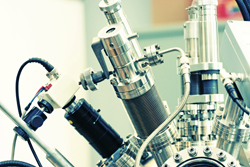A comb to untangle the molecular structure of materials
A graphical representation of an optical frequency comb can be described as having very fine teeth in a beautiful continuum of all possible colours and different lengths. Its spectrum is produced from millions of ultra-short, closely spaced pulses of laser light of different colours, corresponding to the millions of different frequencies (or wavelengths) in the electromagnetic spectrum. Frequency combs, introduced in the 1990s, have revolutionised measurements of frequency and time. They are widely used in optical metrology, have paved the way to atomic clocks and have enabled the highest resolution yet in laser spectroscopy. Entering the realm of molecular spectroscopy, their enormous spectral coverage together with the very high spectral resolution of each 'tooth' of the comb enables the identification of individual atoms and molecules. However, until now, spectroscopy in the mid-infrared (IR) range corresponding to wavelengths of 2 to 20 micrometres, the so-called 'molecular fingerprint', was used minimally by medical and scientific specialists. This was due to the bulky nature of the systems imposed by an indirect method of producing the mid-IR spectrum. Scientists working on the EU-funded project 'Monolithic frequency comb generators in the mid-infrared' (IRCOMB) have demonstrated for the first time the direct production of mid-IR frequency combs based on novel techniques and choice of materials that enable compact packaging. The miniaturised source consists of a crystalline microresonator pumped with a continuous-wave laser. Using a non-linear process called four-wave mixing, scientists have produced a broad comb spectrum near 2.5 micrometres that is poised to revolutionise science and medicine. IRCOMB has extended frequency comb spectroscopy into the molecular fingerprint region in a small, compact device suitable for use by medical and scientific experts. The extremely high-resolution technology promises to open new windows of understanding of the molecules that make up engineered materials, living organisms and the Universe.







